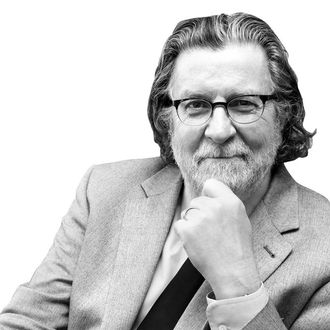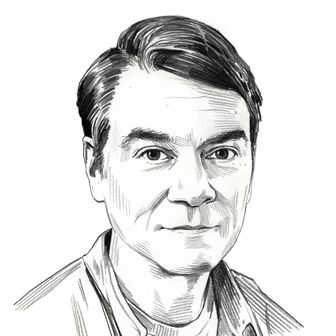
You review health coverage in the media. Let’s talk about some of worst offenders. I noticed you’re not really looking at Self magazine — blueberry juice, antioxidants, you know, all that kind of stuff.
That would be like shooting fish in a barrel.
What about TV?
For our first, I think it was, two and a half years, we were knocking ourselves out to review the actual on-air product of both the ABC, CBS, and NBC morning programs, as well as the evening news. We stopped after a sample of around 223 stories, because they were clearly the worst, predictably the worst, and they were not getting any better. And in fact, one of the three networks virtually said, “Don’t even bother to email us anymore to review us, because we don’t believe in what you’re doing.”
Why don’t they care? Is it: “We don’t believe in science”? Or: “We have a purpose, and our purpose doesn’t include actual information”?
It’s more the latter. The whole “We only have 90 seconds or two minutes and we’re not a medical journal” — all of which just rang very hollow to me, because I got my start in television news. I had my own epiphany, and I know that it’s just a matter of what you choose to cover, then how you choose to cover it, what framing you use. And you can cover the same stories with a gee-whiz attitude or lead with your uncertainties and your limitations. If you, in the front office, or even on your editorial staff, want to make the judgment that people don’t want to be hit up front with uncertainties and limitations, that people want to be spoon-fed black and white and certainties, even when they don’t exist, so be it. But I think that you’re making a terrible and a harmful judgment. I should note that after we announced that we were no longer going to review the networks, suddenly they — in the form of the three lead correspondents at the time, from the three networks — reached out to me in a way that they’d never done before. By slapping them down a bit, it’s clear that we got their attention more than before. In fact, I know that with at least two of the three networks, we have a pretty good fan base of key people right now.
But uncertainty is such a hard thing to make into a story sometimes.
Yet, if, on this beat, you believe that what you’re doing is, on some level, helping people understand and even make decisions, then the failure to grasp uncertainty is really a fatal flaw. That’s why we get into these awful, really ugly public dialogues, parallel probably only to Capitol Hill, about screening tests, for example; we get these raging duels from the true believers, who say their life was saved by a screening test, which of course can never be proved, versus those … it’s really not even an equally pitched battle. It’s not as if you have people saying that screening is terrific, and then on the other side, people saying screening shouldn’t be done. No, not at all. There are people who say, generally, that we ought to screen everybody for everything, and the other side says, “Wait a minute. There are harms. This should be a personal decision, and we shouldn’t be presenting it as a slam-dunk.”
The reason that I hit on screening so often is that, again, in this public-understanding and public-education mode, if we don’t get the upstream screening issues correct, it seems to me we don’t stand any chance of educating the public on downstream treatment issues; that if you truly believe that there aren’t any harms to screening and we ought to be checking every man’s blood for PSA levels, and checking women at an ever-younger age for breast cancer, regardless of any negative consequences, then you really are blind to the very real harms that occur from downstream effects. And if you go into a test with that attitude, when you find something, it seems that you are already conditioned to do something about it. That’s a whole other set of issues, because, as you well know, maybe not everything you find with a PSA test is something you’d want to treat, and maybe not everything you find in a mammogram is something that you’d want to treat.
So is journalism having a negative effect on our health care?
We in journalism have to look in the mirror and accept not all, but some significant degree, of responsibility for the fact that we spend a greater percentage of GDP on health care than anybody on the face of the earth, and we don’t have the outcomes to show for it. We see that every day, with this pill for every ill, whipping the worried well into a frenzy, raising unrealistic expectations about what health care can deliver — and in so doing, raising undue demand for unproven technologies that, once we do have the evidence, we might find cause more harm than good.
That’s the sick-puppy world that I live in, that when you look at media messages every day, you really see quite clearly that this is what we do over and over and over again. So that’s in my mind, and I know very few look at it this way. This isn’t a journalism-improvement initiative so much as it is a rubber-meets-the-road health-care-reform initiative. We’re trying to help Joe Blow improve his critical thinking about claims that he hears about any intervention from any source, including from his own doctor.
Do you see any bright spots?
Some of the public debate through the media — I’ll just take screening tests as an example again — has improved. I interviewed Laura Esserman, who’s really a leading breast-cancer researcher at UCSF, and she recalled the hate mail that she used to get ten or 15 years ago from women saying, “What do you mean a mammogram didn’t save my life?” And she gets far less of that today.
Before you were a watchdog for the mainstream media, you worked in it. Tell me about your experience at CNN.
The attraction was that we had a ten-person medical-news unit: eight in Atlanta and two in Washington. But the only reason it was so large was that it was sponsored by the drug company that was then named Bristol-Myers, now Bristol-Myers Squibb. And I knew that before I accepted the job. I brought it up in the job interview, and my memory is that I almost literally was paternalistically patted on the head and told by a senior executive, “Don’t worry, we’re not going to jeopardize the reputation of the world’s most important network by caving into a sponsor.”
Well, before it was all over, I had in my mind evidence on two occasions of one of two things happening, and I don’t know which one was worse: whether it was direct sponsor interference, or worse yet, in my mind, management perceiving the sponsor looking over their shoulder and acting accordingly. So now I was managing this ten-person department, and many of them were younger, and I felt on many days I couldn’t look them in the eye. I felt on many days they were in a terribly conflicted situation, where I was telling them one thing and the much-higher management of the rest of the news organization was pushing them in quite a different direction. That conflict was palpable. This is not an exaggeration. It even got to the point where if some of these younger staffers would represent our unit in a network-wide editorial meeting, they would actually be told to do things behind my back, because they knew that I would be obstructive.
In terms of “Cover this story”?
And obstructive simply means I ask good questions. It was a very — it was very bittersweet, because there wasn’t anybody else with ten-person medical-news units, and for much of that time, we did a lot of very good stuff. But I think that you can look at much of what’s still done on CNN today, and see the link to what changed back in the late ’80s, and finally in ’90 or ’91, when I left.
What changed?
You don’t have to practice journalism on this beat; you only have to make sure you have everything that everybody else does. So, instead of using the 24 hours daily, which is why I joined CNN, thinking that that would be the opportunity to do in-depth analysis, context, background — no, the 24 hours became the wire service of the air, putting out wildfire wherever they were. So I remember that we, being based in Atlanta — I’m not kidding — in those morning editorial meetings, you would be asked not only why you didn’t have something on what the Times or the Wall Street Journal had that day on A1, but you would be asked, “Why don’t you have something on what is on page 46C of the Atlanta Journal Constitution?” Anything and everything suddenly became not only fair game, but necessary game. So the whole idea of being able to drop back and give analysis, background, context, was gone, because you had to feed the beast.
And now, of course, it’s gotten worse.
Click rates. Click rates just dominate. It is really sad to talk with 30-, 40-year veterans who know their stuff, and they know what they’re being judged on. It’s not the quality or the shoe leather or the extra source or the angle that nobody else has. It’s only the web metrics, on many days. I don’t know, maybe I should retire.
What kind of misinformtion do you most worry about getting out to the public?
I refer to coffee as the poster child of miscommunicated observational-research findings. Hardly a month goes by that we’re not hearing that coffee protects against something, or coffee increases the risk of something else. We’re not training people to understand that observational research, while not unimportant, cannot establish cause and effect, so it can’t establish the proof of a causal link. It can certainly become a strong smoking gun, and in fact, if it had not been for observational research, we wouldn’t have the warnings about cigarette smoking that we have today. But over and over and over again, this is one of the biggest categories of miscommunication and confusion to the public, and it’s one of the drivers of the numbing effect that I talked about earlier.
There’s good observational research, but there’s just a lot of junk. There’s junk observational research in the nutrition field, for example, to the point where, if I get my grant renewed, one of the things that I want to do, starting next year, is a whole parallel, separate effort on how poor much of the nutrition research is — and then how poor so much of the journalism and communication about nutrition research is. In December, a University of Maryland news release promoted a piece of translational research — [meaning] it was a collaboration between one of their researchers and private industry — and it was a news release saying that this researcher’s specialized chocolate-milk concoction had improved concussion symptoms in high-school football players. Did you hear anything about this?
It rings a bell.
And we’re now reviewing health-care-related news releases, and so that one fortuitously fell in our hopper, and it just smelled right away. Our antennae went up immediately. We published our review, but one of our reviewers didn’t stop there, and went to the university and said, “We reviewed you. You didn’t do very well in our review, but we want to know more” — because there really wasn’t any data in this news release. We were immediately stonewalled. Within eight days of our review, the university — which, it’s now clear, was reeling after we pulled the cover back on what was being promoted — announced an internal review. Three months later, which was just last March, they announced the results of that internal review, which made 15 sweeping recommendations. They admitted that they were very concerned about the total lack of awareness of rigorous scientific-research processes, the total lack of concern for conflicts of interest — because the researcher’s department had received a $228,910 grant from some milk foundation, and the researcher didn’t disclose it because, he said, “The money didn’t come to me, it came to my lab.”
Finally, among the things that stood out to us, was that the university admitted that they had a completely dysfunctional news-release-review and dissemination process. In this case, they turned the responsibility of the final news release over to the principle investigator, who of course wanted to promote his own work. But one of the subthemes that jumped out at me here was the researcher admitted, when the internal reviewers interviewed him, that he didn’t see what was wrong with promoting this research — because after all, it was the type of translational research project that the state of Maryland encourages and the university promotes. So he was like a little boy feeling slapped down a bit, but saying, “I thought this is what you wanted us to do.” I think that it is just an outstanding example of problems at so many different levels of the food chain. But how would the public ever know about some of these growing number of partnerships between academics and industries?






























